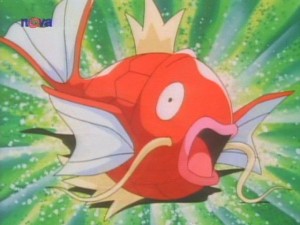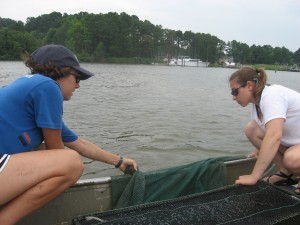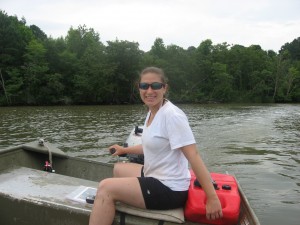by Katie Sinclair
There is a certain art to the deployment of a crab tow. This brown metal and net contraption, about three feet long and a foot wide, scrapes over the bottom in search of juvenile blue crabs. Fitting three people, two coolers, a selection of buckets and bins and the tow in a 16-foot jon boat is something akin to a giant game of Tetris. Successfully launching and recovering the crab tow without smacking anyone in the face or knocking anything overboard requires practiced choreography and grace.
With a one-two-three, the metal tow hits the water with a splash. After 300 feet, lab tech Paige Roberts gracefully maneuvers the jon boat backwards and forwards to retrieve the tow. Paige captains the jon boat a bit like a fighter pilot—precision is required to coax the unwieldy boat around shoals, patches of sea grass and oblivious jetskiers.
It takes two people to haul the tow in and dunk it free of mud. After several rounds of sampling, the process becomes almost automatic: Crab tow goes flying through the air, tow is pulled out of the water, tow is pushed to other side of the boat, a bin appears, and the tow’s catch is shaken loose.
Besides blue crabs, several other species are caught in the tow. Biologists identify them, measure them, and then throw them back. While you may be well aware of the hazards of blue crab handling, it is important to note that several Chesapeake Bay fish species also have their own spiky surprises. You have to quickly master avoiding the spines of a white perch or brown bullhead catfish—and when a 2-foot-long carp gets stuck in a tow and is doing its best to flop out of its bucket, you may be tempted to run for cover.

Artist’s rendition of a carp trapped in a bucket. (Photo credit: Magikarp, designed by Ken Sugimori, OLM, inc)
The pinnacle of crab tow teamwork is seen in the “crab pass,” involving a cantankerous crustacean doing its best to relieve you of your fingertips. In order to verify a crab’s molt stage, sometimes a second opinion is needed. The crab, grasped between its carapace and back swimmer (a safe spot to avoid those claws) is carefully handed to the resident crab expert, who will grab the opposite swimmer and carapace. Obviously, this requires clear communication and quick reflexes, as crabs are not known for their cooperative spirit.
Researchers at SERC have been sampling the summer juvenile crab population since 2007. The long-term dataset can be compared with the results from Maryland’s winter dredge survey, mortality studies, and habitat surveys. Although crab towing involves many hours spent under the hot sun, risking life and limb (or rather, sunburn and fingers), the data collected plays an important role in the Crab Lab’s understanding of the distribution of juvenile crabs in the bay.
So that’s why, summer after summer, SERC’s trusty jon boat can be found puttering around the Chesapeake’s many rivers and creeks. Each year brings another chance to perfect the many steps of the crab tow tango.



